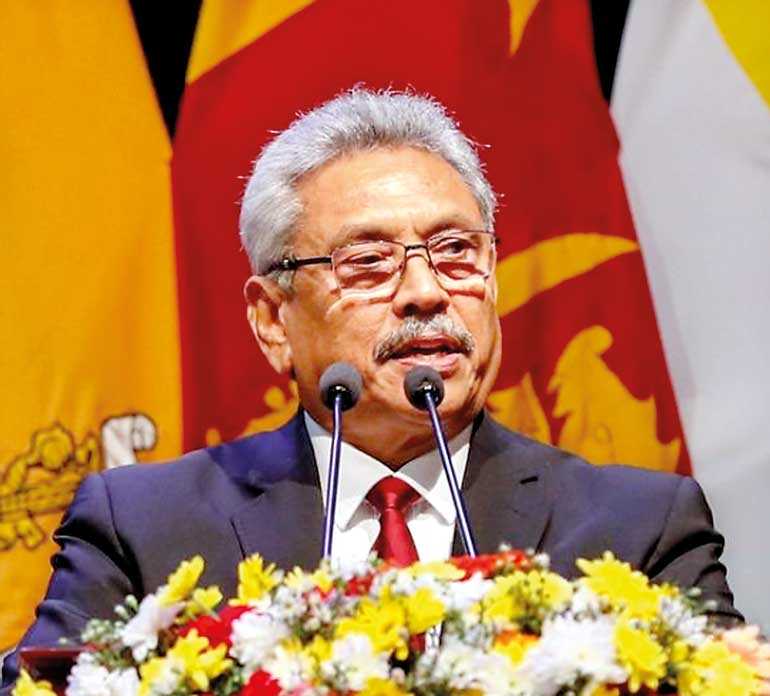Tuesday Jan 21, 2025
Tuesday Jan 21, 2025
Tuesday, 16 June 2020 00:31 - - {{hitsCtrl.values.hits}}

President Gotabaya Rajapaksa
James Thurber, the American author, wrote a fascinating story called ‘The Secret World of Walter Mitty’. It is about a man who has heroic daydreams. When he was driving his car he became a pilot of a plane doing a dangerous landing through low cloud with poor visibility, or a racing driver winning a famous race in a thrilling finish, etc.
What this article triggered was a recognition that most people from time to time have a Walter Mitty episode imagining themselves playing some important role. There are many facets to the Walter Mitty syndrome and all helping a person to feel good. During a friendly argument over a drink, a person may say “they should make me the minister” and “if I was the minister this is what I would do”. This makes him feel good.
Politicians also enjoy making grand statements and revel in the applause they get. A hero for a minute. It gives them a good feeling of importance to make these promises.
With COVID-19 hovering over us like a dark cloud, some like to believe they have great knowledge and get pleasure in making pompous pronouncements about what has to be done to start explosive growth. Here is a typical piece: “We need growth that is sustainable, productive, job-creating, environmentally friendly, and above all growth that enables the masses to improve their quality of life and wellbeing. And we need growth that significantly reduce, not exacerbate, poverty and income disparities.”
Of course they have no solution to achieve this, but it makes them feel good and important to utter this nonsense. All these are Walter Mitty type of scenarios, creating an imaginary experience that gives pleasure.
The President’s aspirations
From time to time he polishes another facet of his ideal Sri Lanka and appoints a task force to deliver it. As he is now doing this fairly frequently one tends to wonder if he is also just having Walter Mitty episodes and creating a good feeling for himself by announcing grand plans for a better Sri Lanka.
Is he Walter Mitty Rajapaksa? I don’t think so. I think he genuinely wants to create a better Sri Lanka, but does not know as yet how to do it and seeks refuge in appointing task forces, as his weapon to achieve his objectives. He does not know the saying that a camel is a horse designed by a committee.
The place to look to, on how to do it, are the major multinationals. They have the best proven management systems. The core principle on which their whole structure is based is individual responsibility and not collective responsibility. They do have boards, but they don’t run the business. Their role is to keep continuously under review the performance of the individual running the business, and to fire him and appoint another if he is not performing well. So it’s a shame the President skews towards task forces and collective responsibility and not individual responsibility and talented individuals.
A project does not always need to have a bricks and mortar content. It could be a project to ensure that nobody in prison had access to drugs. Whatever the project it does not just happen. There are road blocks that need to be negotiated. What is needed are good processes to progress projects and to measure progress. I will relate a true story to highlight some of the key elements of the processes required to complete projects successfully.
Donor-funded projects in disarray
When CBK was President a large number of donor funded projects were in disarray and there was little progress in implementing them. The donors all important countries or organisations were regularly complaining to the President. She was embarrassed. At the time I was the Senior Advisor to the Ministry of Finance and she asked me and I agreed to set up a unit to execute all donor-funded projects.
I had been on the main board of a major multinational in the UK for many years and getting projects implemented was familiar territory. However, I had no experience of implementing Government projects. At the time Prime Minister Mahathir in Malaysia was achieving rapid growth and driving through a large number of new projects. I thought it would be great to get some insight into how he was doing it.
I thought I will try the usual Sri Lankan trick of finding a friend who had friend who could help. I was very lucky as the first Malaysian friend I contacted did have a good friend who headed Mahathir’s project development and implementation unit. So it was on a plane and off to KL. I spent a fascinating day trying to understand how Mahathir did it.
Prime Minister Mahathir’s method
There were three prongs in his approach. The first was his keenness on developing new projects. The project development unit was next to his office with a connecting door! This unit developed a series of possible projects and these were presented to his Cabinet. After intensive debate and discussion the projects to pursue were selected. Therefore there was complete ownership of the projects and the relevant ministers were responsible for implementing the projects.
The second prong was to compile for each project a complete profile which listed every activity, its start date, its end date, the budgeted cost and the actual cost. This was kept up to date and provided a clear rolling picture on progress. The third prong was a monthly meeting chaired by Mahathir. The only items on the agenda were projects running behind schedule. The relevant minister had to explain his remedial measures to get it back on track. I was told that Mahathir gave them hell (whatever that may have been) if the project was behind schedule. He might have done this with well-chosen words spoken softly. The thrust of his approach was that those who did not perform were embarrassed in front of their peers. For a politician there is no harsher or more painful punishment.
CBK’s approach
I was full of enthusiasm for the Mahathir method and met the President on my return. I explained the Mahathir method and said I wanted to implement it. The President was very enthusiastic about monitoring progress, but flatly refused to embarrass the non-performing ministers in public. My plea that it was a core part of the Mahathir method was met with the comment, “I am not Mahathir.” So that was that.
I was furious. When I calmed down, I felt that it was a very smart call by the President. She had probably tried this approach in the past with no success, as they did not have the knowhow to implement projects. So going back to what had failed was not good sense.
I thought we needed a different monitoring and mentoring model. So instead of expecting the minister to solve the problems the mentoring unit will attempt to do so.
The Cabinet appointed me to head a project implementation unit. To support it on matters which require policy changes and political level intervention a cabinet sub-committee was appointed under the chairmanship of the President with the prime minister and three senior ministers.
The project monitoring and mentoring unit
I took over the staff and premises of the Planning Department. I was fortunate to have V. Sivagnanasothy as my assistant. He was very bright, well qualified and was good with people. He had not reached the exalted status of a secretary then, but subsequently did and was secretary of a number important ministries.
We got the IT bit sorted out quickly and we had a replica of Mahathir’s system up and running in a month.
The project directors were given a crash course in project management and they did a great job in getting all the projects on to the system. For every project we had a complete schedule of activities, with a start date, and an end date for each activity, and columns for budgeted cost and actual cost for each activity. We had an extra column for funds required and funds received, as providing funds was a very frequent problem as the Treasury was always short of funds.
How it ticked along
The system was interactive like email and the project directors could communicate any issues on the system and we could respond. We had a pool of people with each assigned a number of projects. They followed progress and spoke regularly to the project directors and built a relationship and were the first line to sort out any problems. What they could not resolve went up to Sivagnanasothy and the secretary. If they failed it came to me.
Generally problems were not solved quickly, because the relevant ministry secretary was dawdling along at their usual pace. If I took up delays with the minister he would defend the secretary as they had a symbiotic relationship of inefficiency. Therefore I took it up aggressively with the secretary with an unsaid but implied threat that I would complain to the President about the minister and his secretary. This access to the President was the only grease that made the wheels of bureaucracy turn and was an important contributor to the success of the project monitoring unit.
The system could be accessed by anyone with the password. When the system was running well a presentation was made to the entire cabinet and their ministry secretaries. As it was still the early days of IT they were amazed to be able to see the exact status of all projects on their computer screen. I told them that we had teams monitoring progress on a continuous basis and that I had to report regularly to the President. She told them that she too had the system on her computer and would track progress. To give this credibility, I pleaded with her secretary to send from her computer (with her approval) a brief comment periodically such as “well done, I see that phase 2 has been completed”.
President Rajapaksa – Walter Mitty episode or serious commitment?
Most politicians have episodes of Walter Mitty, about making great changes that produce sparkling results. We would like to believe that the President is serious and wants to achieve what he has asked his committees and task forces to do. If so he must remedy the gap in his armoury of initiatives and put in place the master initiative a project monitoring and mentoring unit that will help him to achieve all his objectives.
A monitoring unit will tell the President at a glance on his computer screen the progress or the lack of progress of every project. If a project is not going well he will see the reasons for it and have the opportunity to fix the problems. Importantly, the system will give him the financial profile of costs against budgets.
He would also benefit from following the Mahathir method of a monthly review meeting with an agenda of projects lagging behind. I wanted to make the project monitoring system open to everyone and to publish the password in the papers.
I moved on before I could do this. Perhaps he should consider this.
If the President wants to put in place a project monitoring and mentoring system the ideal man to put the nuts and bolts together is V. Sivagnanasothy (now retired perhaps?), a senior secretary till recently. He did an excellent job putting together the first monitoring system.